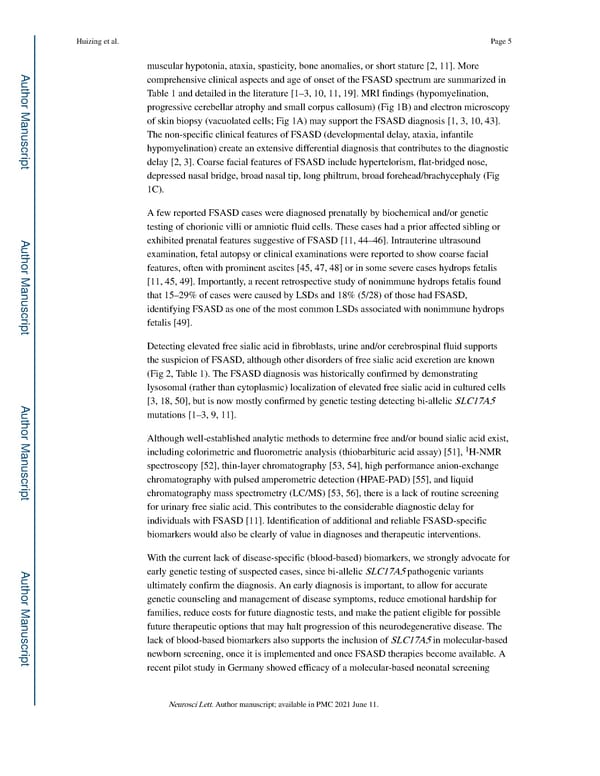Huizing et al. Page 5 muscular hypotonia, ataxia, spasticity, bone anomalies, or short stature [2, 11]. More A uthor Man comprehensive clinical aspects and age of onset of the FSASD spectrum are summarized in Table 1 and detailed in the literature [1–3, 10, 11, 19]. MRI findings (hypomyelination, progressive cerebellar atrophy and small corpus callosum) (Fig 1B) and electron microscopy of skin biopsy (vacuolated cells; Fig 1A) may support the FSASD diagnosis [1, 3, 10, 43]. uscr The non-specific clinical features of FSASD (developmental delay, ataxia, infantile hypomyelination) create an extensive differential diagnosis that contributes to the diagnostic ipt delay [2, 3]. Coarse facial features of FSASD include hypertelorism, flat-bridged nose, depressed nasal bridge, broad nasal tip, long philtrum, broad forehead/brachycephaly (Fig 1C). A few reported FSASD cases were diagnosed prenatally by biochemical and/or genetic testing of chorionic villi or amniotic fluid cells. These cases had a prior affected sibling or A exhibited prenatal features suggestive of FSASD [11, 44–46]. Intrauterine ultrasound uthor Man examination, fetal autopsy or clinical examinations were reported to show coarse facial features, often with prominent ascites [45, 47, 48] or in some severe cases hydrops fetalis [11, 45, 49]. Importantly, a recent retrospective study of nonimmune hydrops fetalis found that 15–29% of cases were caused by LSDs and 18% (5/28) of those had FSASD, uscr identifying FSASD as one of the most common LSDs associated with nonimmune hydrops ipt fetalis [49]. Detecting elevated free sialic acid in fibroblasts, urine and/or cerebrospinal fluid supports the suspicion of FSASD, although other disorders of free sialic acid excretion are known (Fig 2, Table 1). The FSASD diagnosis was historically confirmed by demonstrating lysosomal (rather than cytoplasmic) localization of elevated free sialic acid in cultured cells A [3, 18, 50], but is now mostly confirmed by genetic testing detecting bi-allelic SLC17A5 uthor Man mutations [1–3, 9, 11]. Although well-established analytic methods to determine free and/or bound sialic acid exist, including colorimetric and fluorometric analysis (thiobarbituric acid assay) [51], 1H-NMR uscr spectroscopy [52], thin-layer chromatography [53, 54], high performance anion-exchange chromatography with pulsed amperometric detection (HPAE-PAD) [55], and liquid ipt chromatography mass spectrometry (LC/MS) [53, 56], there is a lack of routine screening for urinary free sialic acid. This contributes to the considerable diagnostic delay for individuals with FSASD [11]. Identification of additional and reliable FSASD-specific biomarkers would also be clearly of value in diagnoses and therapeutic interventions. With the current lack of disease-specific (blood-based) biomarkers, we strongly advocate for A early genetic testing of suspected cases, since bi-allelic SLC17A5 pathogenic variants uthor Man ultimately confirm the diagnosis. An early diagnosis is important, to allow for accurate genetic counseling and management of disease symptoms, reduce emotional hardship for families, reduce costs for future diagnostic tests, and make the patient eligible for possible future therapeutic options that may halt progression of this neurodegenerative disease. The uscr lack of blood-based biomarkers also supports the inclusion of SLC17A5 in molecular-based ipt newborn screening, once it is implemented and once FSASD therapies become available. A recent pilot study in Germany showed efficacy of a molecular-based neonatal screening Neurosci Lett. Author manuscript; available in PMC 2021 June 11.
 Free Sialic Acid Storage Disorder: Progress and Promise Page 4 Page 6
Free Sialic Acid Storage Disorder: Progress and Promise Page 4 Page 6